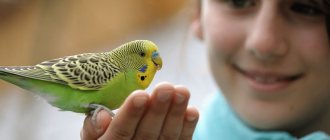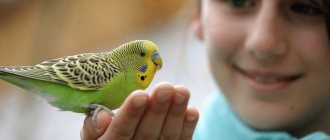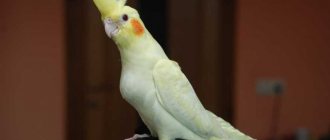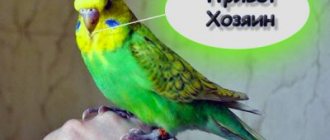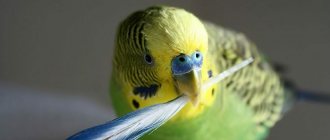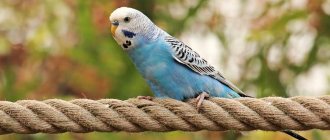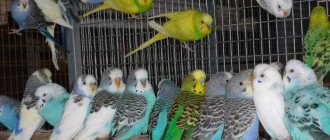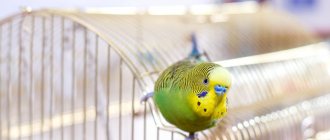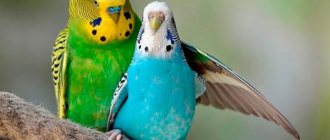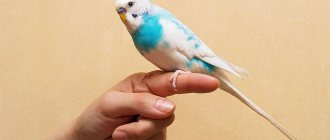It’s easy to teach your parrot the simple words “Hello” or “Kesh is good,” but any owner of such a bird strives to ensure that his feathered pet can speak as many words as possible, especially if these are cool phrases and sentences.
But what can you come up with other than the standards that have already become ingrained in our daily lives, what words and phrases can you still teach your chirping pet, and how many words can a budgie remember?
This is exactly what our publication is about today, from which you, we hope, will learn a lot of interesting things for yourself.
Prerequisites for training
Not all parrots can be taught to speak. Breeds that tend to produce speech include: Grays, cockatoos, budgies and macaws. But among representatives of other breeds there are also talkative individuals. This skill directly depends on the individual characteristics of the birds. This fact should be taken into account in order to choose the right parrot.
Interesting! Many birds are able to imitate dog barking, birdsong and other sounds well, but poorly reproduce human speech.
To understand whether it is possible to teach a parrot to talk, you need to identify a number of nuances:
- sex of the bird;
- absence of stress factors;
- age;
- the conditions in which the pet is kept;
- bird-human relationship.
It is important for a parrot not only to provide the right diet and care, but also to devote enough time for communication and affection. If there is no such attention, you should not expect the bird to be talkative.
What can you teach your feathered pet?
We present to your attention a sign that we have filled with interesting phrases and words, ideal for a budgie.
| Phrases | List of words |
| Protect the environment | |
| be healthy | |
| Behave yourself | |
| Turn on TV | |
| Everything will be fine | |
| Where's my present? | |
| Gosha is good | |
| Let `s play | Hello |
| Give me money | |
| Give me some food | |
| Let me kiss | |
| Give me some champagne | |
| Two by two is four | |
| Good morning | |
| Good evening | |
| Close the window | |
| How are you doing | Guard |
| Who's there? | Come il faut |
| Buy some bread | |
| I'm tired of you | |
| Not a penny in my pocket | |
| Well, brother, goodbye | |
| Got drunk again? | |
| I want some beer | Peach |
| Bye sweet | Piasters |
| Show me the diary | It's time to sleep |
| Chase the cat away | Hello |
| Birdie lays an egg | Birdie |
| Are you happy with me or not? | |
| Good night | |
| I like you | |
| Want to eat | Ciao |
| I want to drink | |
| I'm a green parrot | |
| I'm watching you |
If you received a parrot that is already talking, then in order to learn its vocabulary, you need to wait a little time.
Let your feathered pet adapt to its new home and new owners. And as soon as this happens, in just a few days the wavy will tell you the entire list of words that it knows!
Teaching Methodology
In most cases, only the owner is able to teach the parrot to talk. Attempts to educate other family members are most often unsuccessful. There are quite a large number of techniques for birds. However, not all of them show good results.
"One on one"
She assumes that during training only the owner will be with the bird; there will be no other people in the room. During the conversation, complete silence should be observed, while the person is in a good mood.
Important! This training method is carried out after complete socialization.
Birds learn according to the following rules:
- When entering a room with a cage, the pet owner always says “Hello!” Over time, birds will begin to perceive this as an incentive to copy speech.
- After the greeting, the person comes up and sits near the cage. Talks affectionately to the pet. At this time, phrases should be spoken that bring the bird to joy.
- If the pet likes to sit on the owner’s hand or next to him, it is allowed to carry out training in this position.
- When pronouncing syllables, it is advisable to choose those that contain the letters “a” or “o”, “r”, “p” or “t”.
- Syllables and words with the letters “l”, “n” and “m” are not suitable for starting studies.
- When a choice is made, the syllable or short word is repeated for about 10 minutes.
- At the end of the lesson, the bird is given its favorite treat.
- When leaving, say “Bye!”
New words are added after the pet has learned the old ones.
Under a tape recorder
This method of training a bird does not require the presence of a person. His voice is recorded on a voice recorder. The lesson involves clear pronunciation of several syllables or short words with repetition. The conversation recording starts at a certain time when the pet is in a good mood.
The training procedure involves several stages:
- A high-quality lesson recording is created. On it, the owner of the bird clearly pronounces the syllable, who repeats it after 3-5 seconds. The recording quality should be good, without noise or interference.
- When the bird is in a good mood, a tape recorder is brought into its room and the recording is started. It is important that the volume is at a medium level. Excessively loud or quiet sound is not acceptable.
- The duration of the lesson is 10–15 minutes, after which the tape recorder turns off.
- The parrot is given his favorite treat.
When the bird starts saying a syllable from the audio lesson, the recording changes to another. It is important to carry out this technique for no more than 15–20 minutes. Otherwise, the pet gets bored with the recording, and human speech is perceived worse.
Rivalry
This teaching method involves the involvement of two family members. The bird should know these people well. The lesson is conducted for two: for the assistant and for the bird.
This type of training requires some rules:
- Two people enter the room where there is a cage with a parrot: the owner of the bird and his assistant. At this time, there should be silence in the house, and the bird should be in a good mood.
- When entering the room, both people say “Hello!”
- Next, people sit near the parrot’s cage and communicate with each other. This behavior will arouse the bird’s interest and desire to join the conversation.
- The teacher clearly pronounces the syllable every 3-4 seconds. The second person repeats this syllable.
- The lesson lasts 15 minutes, after which people leave the room with a goodbye “Bye!”
Interesting! Girls are better at learning human language than boys.
The effectiveness of such training lies in the desire to compete and quickly understand the material.
Simple phrases for a parrot
Any breeder of feathered pets dreams of his ward learning as many suitable phrases for a parrot as possible. Talking pets themselves are valued much more than just domesticated birds. At the same time, preference is often given to those pets that can parody human speech.
If you want to have such a feathered talker at home, then you have two options. Firstly, you can always buy an already trained pet. In the second of these cases, you will have to spend as much time as possible with your parrot, talking and playing with him.
At the same time, experienced breeders emphasize that for successful training you will need to choose as many suitable words for the parrot as possible. In this case, we mean the fact that the pronunciation of some phrases is much easier for your parrots than others. So what phrases are we talking about?
You should pay attention to words containing letters such as “ch”, “sh”, “sch”, “r”. Pronunciation of these letters is easier for parrots than for others. Accordingly, words containing these letters are remembered by birds much easier and faster.
However, this does not mean that the parrot will immediately remember the phrases you say. In order to teach your pet each of the planned words, you will need to show considerable persistence and repeat it day after day. Until the pet tries to pronounce it on its own.
In addition, the parrot must be quite tame and trust the person who tamed it.
In order for your pet to learn the words you speak as quickly as possible, you can use one trick. Offer him some sweets at the end of your conversations. This way, the parrot will get used to the fact that he will definitely receive a treat for any success.
However, you shouldn’t force yourself on your parrot either. If the bird is tired or simply does not want to communicate with you at the moment, leave it alone.
Selection of words and phrases
You need to choose the right syllables and sounds to teach your parrot to speak. You can also start training with the pet's name. There are no problems with pronouncing the name. As you learn, the task gradually becomes more difficult.
First stage
The easiest way for a bird to recognize its own name. Her pet hears from all family members from the moment he arrives in his new home. To force the parrot to pronounce it, it is necessary to clearly pronounce the name when approaching the cage, while eating, and when the bird is in a good mood.
Important! In addition to the nickname, no other words or phrases should be used; this will confuse the bird and complicate its training.
Basic set of words
If you have managed to teach your parrot to speak syllables and a nickname, you can begin to increase your vocabulary. To do this, a basic set of words or short phrases is determined. These can be cool phrases or basic expressions.
Further training occurs according to the principle:
- A person approaches the cage and says “Hello, Kesha! (parrot's nickname)."
- While treating the bird they say “Kesha eats”, “Kesha drinks”.
- During hygiene procedures: “Kesha is cleaning her beak,” “Kesha wants to take a shower.”
- While the bird is resting, the phrases “Kesha is happy”, “Kesha is happy” are said.
- When a pet is angry or capricious, it’s time to say “Kesha is angry,” “Kesha is angry.”
All phrases are learned one by one. There is no need to say different words all the time, this will only confuse the parrot. The following phrases are pronounced after mastering the previous ones.
Situational conversations
Gray parrots, macaws, cockatoos and other large birds are most prone to talking. You can teach it to a bird if you regularly voice all its actions.
“Repetition is the mother of learning”
If you keep a couple or more birds in your home, then teaching them to say the simplest set of words or phrases when they are in a flock is almost impossible. To get your pet flyer to talk, you need to isolate it from other birds. This is the only way you can teach your budgie to talk.
As for the timing of classes. Most experienced ornithologists believe that it is best to work with wavy birds in the morning, when they are hungry, alert and in a good mood. To increase the effectiveness of the training, it is recommended to remove the feeder from the cage at night so that in the morning the bird is really hungry and immediately follows your instructions, in return for which it would receive the long-awaited food.
In order for the bird to speak as quickly as possible, it is necessary to regularly pay attention to it. It is believed that two trainings a day lasting no more than 10 minutes are enough for the bird to start chirping soon. You need to repeat a word or phrase many times.
Currently, many breeders of such animals have adapted to play a repeating audio recording for their pets, on which the owner’s voice is recorded.
It is not recommended to include phrases or a list of words from the Internet and other sources for your budgerigar, since the bird will stop responding to the voice of its owner and will not be trainable.
As soon as the training comes to an end, you need to feed your feathered pet tasty and satisfying food. Whereas well-fed parrots are not very willing to train.
How long will it take to teach a budgerigar to say phrases or a list of words you have given? No one here can give you a clear answer, because all feathered friends, like people themselves, have different levels of abilities.
Some will be able to speak phrases and simple words after a couple of weeks, while others will need at least a month to do this.
It happens that even regular training does not help the bird speak, and it continues to chirp in its own bird language.
Fast learning method
You can quickly teach your pet to say its name if you pronounce it with already familiar phrases. For this, the learned word “Hello!” is enough. At the sight of a parrot, “Hello, Molly!” is added to it. Actions are pronounced using the same principle: “Molly is eating,” “Molly is thirsty,” “Molly is happy,” and so on.
These phrases should be repeated throughout the day and during training lessons. The fastest way to teach a parrot to speak is at the age of 4–8 months. It is more effective to conduct two lessons a day for 5-10 minutes than a long lesson every 1-2 days.
How should you teach a parrot to talk?
Below is a technique for teaching a parrot to speak. During training, personal contact between a person and his winged friend is important. The use of auxiliary equipment such as tape recorders, voice recorders and computers is not recommended.
- Choose in advance a couple of words or phrases that you will teach.
- During training, the pet can sit both in the cage and outside it, for example, on your hand, a play stand or a table perch.
- Try to choose moments for studying when the student is focused on you.
- The lesson itself goes as follows: the teacher, being next to the bird, repeats the necessary phrases, alternating them among themselves (10-20 times one phrase, 10-20 times the second, and so on).
- It is advisable to use these phrases not only during classes, but also in everyday life. This promotes memorization.
- If you feel that the bird is losing interest, then stop the activity.
